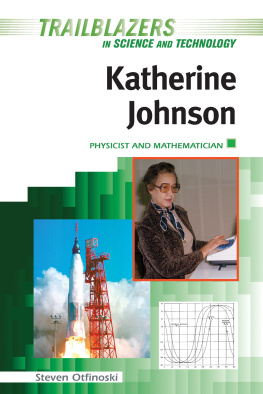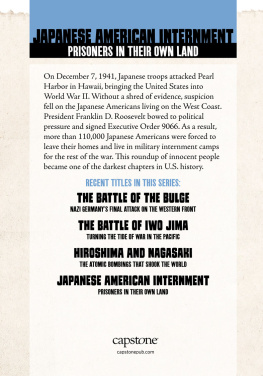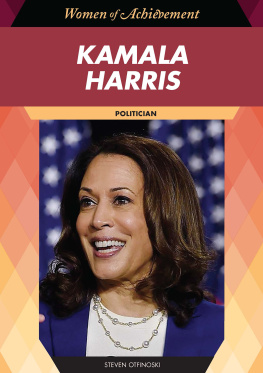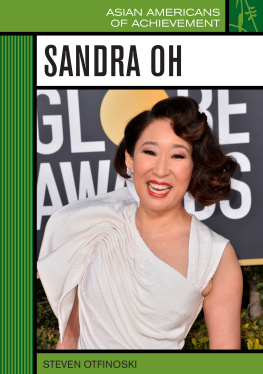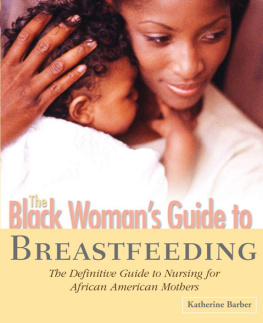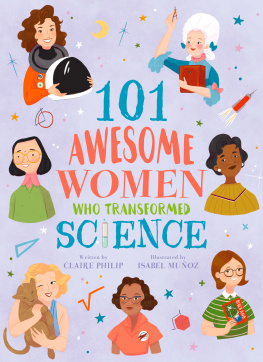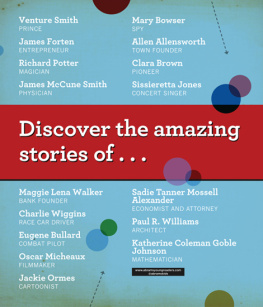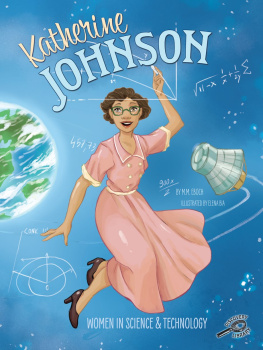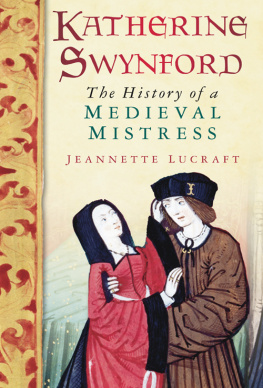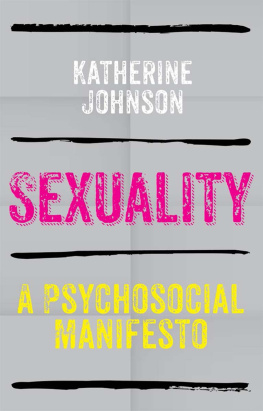Steven Otfinoski - Katherine Johnson: Physicist and Mathematician
Here you can read online Steven Otfinoski - Katherine Johnson: Physicist and Mathematician full text of the book (entire story) in english for free. Download pdf and epub, get meaning, cover and reviews about this ebook. year: 2019, publisher: Infobase Publishing, genre: Non-fiction. Description of the work, (preface) as well as reviews are available. Best literature library LitArk.com created for fans of good reading and offers a wide selection of genres:
Romance novel
Science fiction
Adventure
Detective
Science
History
Home and family
Prose
Art
Politics
Computer
Non-fiction
Religion
Business
Children
Humor
Choose a favorite category and find really read worthwhile books. Enjoy immersion in the world of imagination, feel the emotions of the characters or learn something new for yourself, make an fascinating discovery.
- Book:Katherine Johnson: Physicist and Mathematician
- Author:
- Publisher:Infobase Publishing
- Genre:
- Year:2019
- Rating:4 / 5
- Favourites:Add to favourites
- Your mark:
- 80
- 1
- 2
- 3
- 4
- 5
Katherine Johnson: Physicist and Mathematician: summary, description and annotation
We offer to read an annotation, description, summary or preface (depends on what the author of the book "Katherine Johnson: Physicist and Mathematician" wrote himself). If you haven't found the necessary information about the book — write in the comments, we will try to find it.
If mathematics is the backbone of science, Katherine Johnsons spine is among the strongest. An African-American woman born in 1918 in West Virginia, Johnson overcame many obstacles and setbacks before procuring a job at an organization that would
Katherine Johnson: Physicist and Mathematician — read online for free the complete book (whole text) full work
Below is the text of the book, divided by pages. System saving the place of the last page read, allows you to conveniently read the book "Katherine Johnson: Physicist and Mathematician" online for free, without having to search again every time where you left off. Put a bookmark, and you can go to the page where you finished reading at any time.
Font size:
Interval:
Bookmark:
Copyright 2019 by Infobase
All rights reserved. No part of this publication may be reproduced or utilized in any form or by any means, electronic or mechanical, including photocopying, recording, or by any information storage or retrieval systems, without permission in writing from the publisher. For more information, contact:
Chelsea House
An imprint of Infobase
132 West 31st Street
New York NY 10001
ISBN 978-1-4381-9555-1
You can find Chelsea House on the World Wide Web
at http://www.infobase.com
A large crowd had gathered for an important ceremony at the National Aeronautics and Space Administration (NASA)s Langley Research Center in Hampton, Virginia. It was September 22, 2017 and a new $23-million building, the third in an ambitious 20-year revitalization program, was about to be dedicated and opened. Among the dignitaries present were Virginia Governor Terry McAuliffe and U.S. Senator Mark Warner (D-VA). They had all come to pay tribute to the person who the building was named in honor of.
Were here to honor the legacy of one of the most admired and inspirational people ever associated with NASA, said Langley director David Bowles. I cant imagine a better tribute to Mrs. Johnsons character and accomplishments than this building that will bear her name.
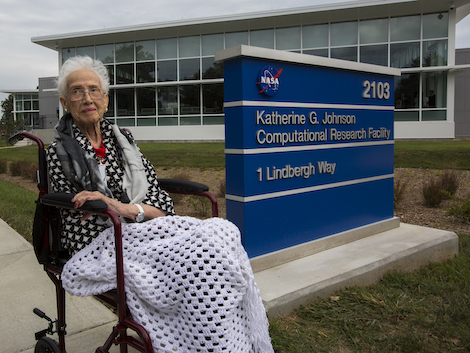
Katherine Johnson in front of NASA Langleys Katherine Johnson Computational Research Facility.
Source: NASA/David C. Bowman
The woman he was referring to was not an astronaut, a scientist or an engineer. She was a frail, 99-year-old African-American woman, seated nearby in a wheelchair. Katherine Johnson never went into outer space, but her skills as a mathematician made it possible for Americas astronauts to soar to the heavens, orbit the Earth and fly the moon and back. Like dozens of other women who worked the numbers at Langley from the 1950s through the 1980s, she was one of the unsung heroes of the space program.
But fame had caught up with Katherine Jonson before this auspicious occasion. She was the central figure in a nonfiction book, Hidden Figures: The American Dream and the Untold Story of the Black Women Mathematicians Who Helped Win the Space Race. The book, by African-American author Margot Lee Shetterly, who was also present at the ribbon-cutting ceremony, was published the previous year. It was quickly followed by a major motion picture also called Hidden Figures that was a box office hit and garnered three Academy Award nominations. Katherine Johnsons star had truly risen. She was no longer a hidden figure but had stepped out of the shadows into the light.
However fame did not change this gifted but modest woman. When she was first told the 37,000-square-foot (3,437 square meter) building would be named the Katherine Johnson Computational Research Facility, she responded, I think theyre crazy.
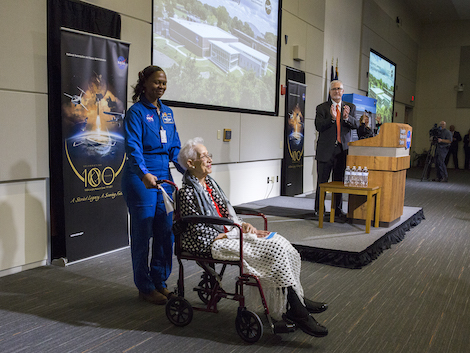
Astronaut Dr. Yvonne Cagle is with Johnson as she receives a standing ovation from the crowd at the ribbon-cutting ceremony of the Katherine Johnson Computational Research Facility.
Source: NASA/David C. Bowman
In an interview taped before the ceremony, she had this to say about her work: I was excited at something new, always liked something new, but give credit to everyone who helped. I didnt do anything alone but try to go to the root of the question and succeeded there. Looking back at her more than three decade-career at Langley, she said humbly, Little did I think it would go this far. But from the beginning, Katherine Johnson exhibited the determination, talent and work ethic that would take her to the far side of her dreams.
She was born Katherine Coleman, the youngest of four children, in White Sulphur Springs, West Virginia on August 26, 1918. Her father, Joshua, was a farmer and part-time laborer. Her mother, Joylette, was a former schoolteacher.
Although the Civil War had ended more than fifty years before Colemans birth, slavery, an issue that divided the nation and led to the war, was not forgotten. West Virginia was originally part of the state of Virginia, but it split apart over a number of issues, including the Civil War. West Virginia was admitted to the Union in 1863, amid the war, and most West Virginians supported the Union and opposed the Confederacy of which Virginia was a part. But slavery existed in West Virginia as in the Southern states, until the Fourteenth Amendment to the Constitution ended the institution in 1865.
Katherine Colemans family had lived as slaves in the region since at least 1799. Her great-grandmother Louisa Johnson, who died in 1869, was probably a slave, but her daughter, Margaret Wheeler, Colemans grandmother, was listed in documents as a free colored woman. Because she was free, her children, including Joshua, were born free as well, according to local laws. Like nearly all African American children, Joshuas education ended in a segregated black school at sixth grade. While he had little schooling, he had a natural intelligence and was particularly gifted with numbers and math. He used his math skills in his work on the farm and in other jobs he held. Always neatly dressed and well spoken, Joshua Coleman was highly respected in the small community of White Sulphur Springs.
Katherine inherited her fathers gift for numbers. As a child shed love to count things, everything from the dishes in the pantry to the steps in front of the church they weekly attended. Anything that could be counted, I did, she later recalled.
She excelled in math in school and in all her other subjects. She was curious about everything and was forever asking teachers and her parents questions. A top student, she was drawn to sharing what she learned with others. When her classwork was done, she would often walk next door to her older brothers classroom and help him with his schoolwork. Her gifts did not go unrewarded. When she finished second grade she was promoted to fifth grade, skipping two grades.
Like their father, the Coleman childrens education was set to end when they finished sixth grade. There was no middle or high school for black children in White Sulphur Springs. The nearest school where African-Americans could continue their education was 125 miles (201 km) away in the town of Institute. It was operated by the West Virginia Collegiate Institute, formerly called the West Virginia Colored Institute.

Main Building at West Virginia Colored Institute, circa 1901.
Source: West Virginia State Archives
Joshua was determined to see his children continue their education and gain opportunities he never had. So he made a bold decision. When his eldest son turned 14, he loaded the family into a wagon and made the long journey to Institute. There, he rented a house for the children and their mother to live in while they attended school from September to May. Then he returned home to White Sulphur Spring to work several jobs to help pay for the familys growing expenses. Meanwhile, his wife worked as a domestic in Institute to help with costs. The family would return home for the summer. This situation continued for the next eight years. We only got to see my father about once a month during the school years, Kathrine remembered. I knew it was a real sacrifice for he and my motherliving separate like that for most of the year.
Font size:
Interval:
Bookmark:
Similar books «Katherine Johnson: Physicist and Mathematician»
Look at similar books to Katherine Johnson: Physicist and Mathematician. We have selected literature similar in name and meaning in the hope of providing readers with more options to find new, interesting, not yet read works.
Discussion, reviews of the book Katherine Johnson: Physicist and Mathematician and just readers' own opinions. Leave your comments, write what you think about the work, its meaning or the main characters. Specify what exactly you liked and what you didn't like, and why you think so.

